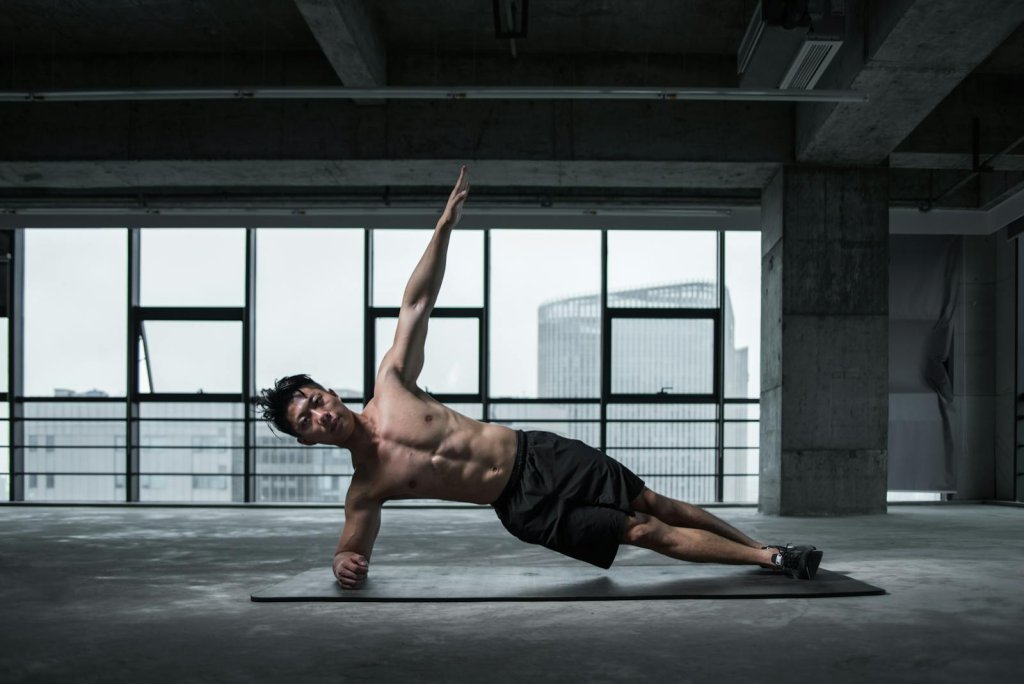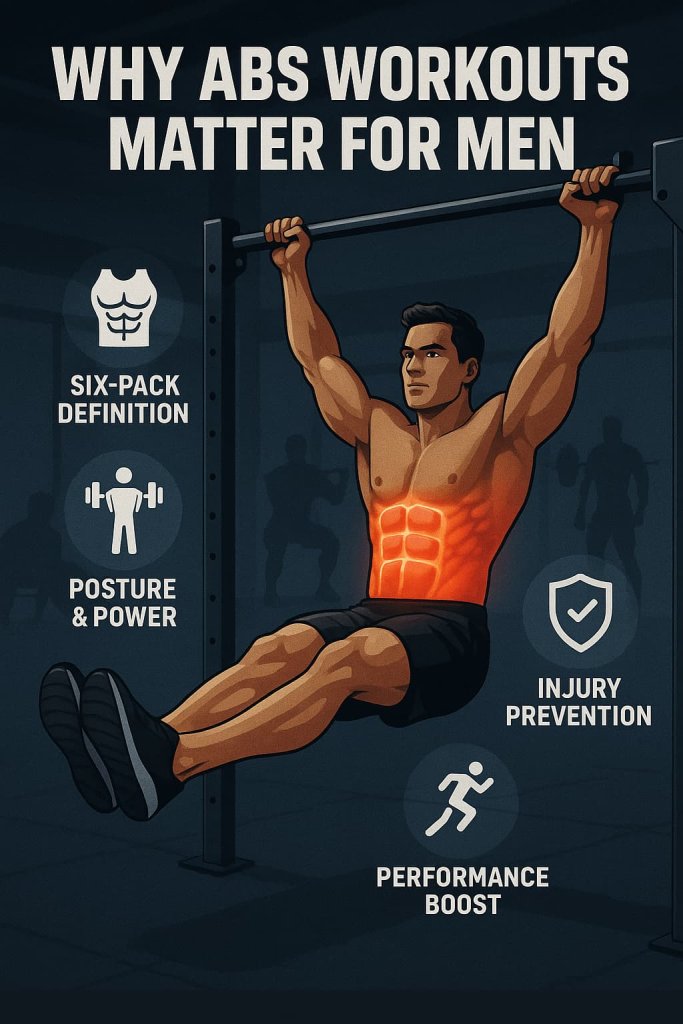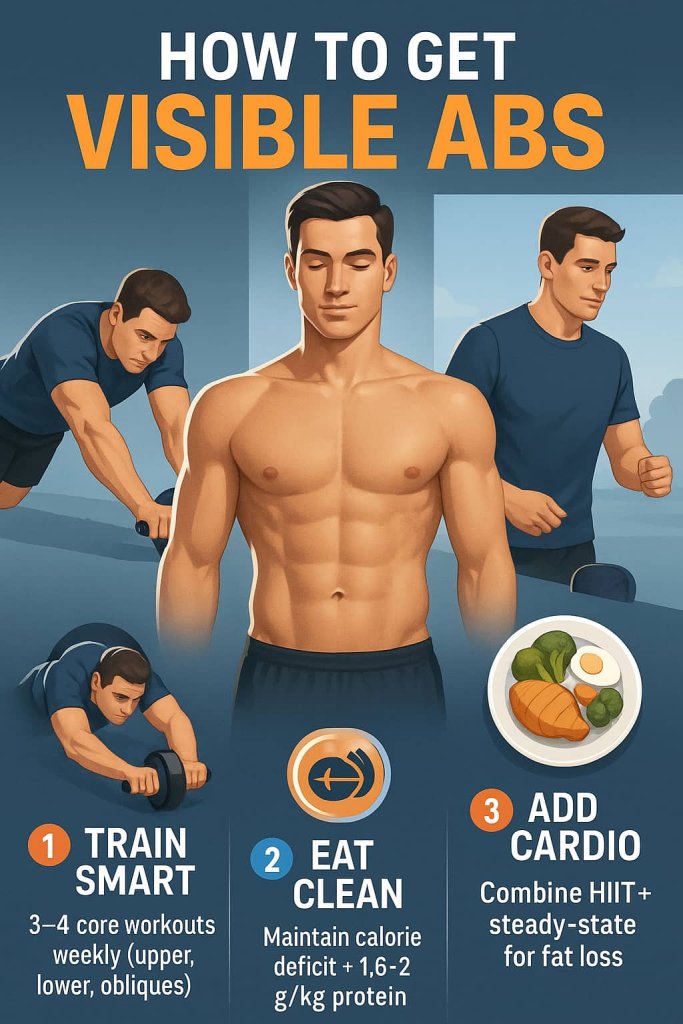Yes — you can build a six-pack fast by combining effective abs workouts with proper nutrition and progressive overload.
While crunches help, true core definition comes from training all parts of your abs — upper, lower, obliques, and deep stabilizers — plus lowering body fat through diet and cardio.

A strong core doesn’t just look good; it improves posture, protects your spine, and boosts athletic performance. This guide covers the 20 best abs workouts for men, backed by recent research and expert recommendations.
Why Abs Workouts Matter for Men
Evidence shows targeted core training over ~8 weeks improves core endurance and trunk performance, while aerobic training of ≥150 minutes/week is linked to clinically meaningful reductions in waist circumference. Together, these support better stability, injury prevention, and performance across lifts and sport.

Strong abs enhance stability, prevent injury, and improve performance in every lift and sport.
Benefits of regular abs training:
- Builds visible muscle definition (“six-pack”)
- Improves balance, posture, and lifting power
- Reduces lower back pain risk
- Supports daily movement and sports performance
How to Get Visible Abs
Getting a six-pack isn’t just about exercises — it’s about reducing overall body fat.

Three key steps:
- Train smart – 3–4 core workouts weekly targeting all regions (upper, lower, obliques, deep core).
- Eat clean – maintain a calorie deficit and consume enough protein (1.6–2.2 g/kg body weight).
- Add cardio – combine HIIT and steady-state cardio to accelerate fat loss.
💬 Expert note:
“Abs are built in the gym — but revealed in the kitchen.”
20 Best Abs Workouts for Men
1. Hanging Leg Raise
Why it works:
The hanging leg raise is a gold-standard lower abs exercise. It targets the rectus abdominis—specifically the lower portion—while also strengthening the hip flexors, grip, and stabilizing muscles in your shoulders and back. Because your body is suspended, it challenges the core to stabilize against gravity, building both strength and endurance.
Muscles worked:
Lower abs, hip flexors, forearms, shoulders, lats.
How to do it:
- Hang from a pull-up bar with your hands shoulder-width apart.
- Engage your core and slowly raise your legs until they’re parallel to the ground (or higher if you can).
- Pause briefly, squeezing your abs.
- Lower your legs under control without swinging.
Trainer Tip:
Avoid momentum — if your legs swing, the abs disengage. Focus on slow, deliberate reps and breathing out at the top of each lift.
2. Ab Wheel Rollout
Why it works:
This move strengthens your entire anterior chain, teaching your abs to resist extension — one of their key functions. It engages deep stabilizers like the transverse abdominis and builds anti-arch strength that directly supports your lower back.
Muscles worked:
Rectus abdominis, transverse abdominis, lats, deltoids, glutes.
How to do it:
- Start on your knees, gripping the ab wheel handles firmly.
- Roll the wheel forward slowly, keeping your arms extended and core tight.
- Go as far as you can without your lower back sagging.
- Pull yourself back using your abs, not your arms.
Trainer Tip:
Don’t let your hips drop. Beginners should roll halfway until they build core stability. Eventually, progress to standing rollouts for maximum difficulty.
3. Weighted Cable Crunch
Why it works:
This exercise allows progressive overload—you can add resistance to continually challenge your abs, much like any other muscle. It strengthens the upper and middle rectus abdominis while improving definition and thickness.
Muscles worked:
Upper abs, middle abs, hip flexors.
How to do it:
- Attach a rope to a high pulley and kneel facing the machine.
- Hold the rope behind your neck or by your temples.
- Contract your abs to curl your torso down toward your knees.
- Slowly return to starting position without pulling with your arms.
Trainer Tip:
Focus on curling your spine, not bending at the hips. Visualize “bringing your ribcage to your pelvis.”
4. Decline Sit-Up
Why it works:
The decline position increases time under tension and range of motion, stimulating the upper abs more effectively than floor sit-ups. It also trains the hip flexors for stability.
Muscles worked:
Upper abs, hip flexors, obliques (secondary).
How to do it:
- Adjust a decline bench to about 30–45 degrees.
- Secure your feet under the pads, cross your arms or hold a plate to your chest.
- Lower your torso slowly until your upper back nearly touches the bench.
- Sit back up by curling your spine, not jerking.
Trainer Tip:
Use controlled tempo: 3 seconds down, 1 second up. Add a plate or dumbbell when bodyweight feels too easy.
4. Bicycle Crunch
Why it works:
Ranked as one of the most effective abdominal moves by the American Council on Exercise (ACE), the bicycle crunch simultaneously targets upper abs, lower abs, and obliques, creating 3D core definition.
Muscles worked:
Rectus abdominis, obliques, hip flexors.
How to do it:
- Lie flat on your back, hands behind your head.
- Bring knees up to 90° and alternate extending one leg while twisting your torso toward the bent knee.
- Continue pedaling smoothly, keeping abs tight.
Trainer Tip:
Slow down — faster isn’t better. Controlled twisting engages the obliques fully and prevents neck strain.
5. Reverse Crunch
Why it works:
Unlike standard crunches, the reverse version focuses on lifting your hips, not your torso — directly engaging the lower abs while sparing your neck and spine.
Muscles worked:
Lower abs, transverse abdominis, hip flexors.
How to do it:
- Lie flat, arms beside you for balance.
- Lift your knees toward your chest while curling your pelvis off the floor.
- Lower back down slowly, keeping constant tension.
Trainer Tip:
Visualize pulling your knees to your chest using your abs, not momentum.
7. Side Plank
Why it works:
This static hold challenges lateral stability, building strength in the obliques, glutes, and shoulder stabilizers. It’s excellent for spinal support and posture correction.
Muscles worked:
Obliques, transverse abdominis, glutes, deltoids.
How to do it:
- Lie on one side, propped on your forearm, feet stacked.
- Raise your hips until your body forms a straight line from head to heels.
- Hold the position, breathing steadily.
Trainer Tip:
To progress, lift your top leg or perform hip dips for dynamic tension.
8. Mountain Climbers
Why it works:
A powerful mix of cardio and core work, this move raises your heart rate while strengthening abs, shoulders, and legs, promoting fat loss and functional endurance.
Muscles worked:
Core, shoulders, hip flexors, quads, chest.
How to do it:
- Start in a plank with your shoulders over your wrists.
- Drive one knee toward your chest, then switch legs rapidly.
- Keep hips low and back flat.
Trainer Tip:
Maintain control — don’t bounce your hips. Focus on speed and alignment.
9. Russian Twist
Why it works:
One of the best rotational exercises for building oblique definition and core coordination. It enhances rotational power used in sports like boxing or golf.
Muscles worked:
Obliques, rectus abdominis, lower back.
How to do it:
- Sit with knees bent, feet slightly elevated.
- Hold a weight or medicine ball and rotate your torso side-to-side.
- Tap the floor gently on each twist.
Trainer Tip:
Keep chest lifted and abs braced — avoid rounding your back.
10. Flutter Kicks
Why it works:
An endurance-based exercise that maintains constant tension in the lower abs while engaging the hip flexors for stability.
Muscles worked:
Lower abs, hip flexors, quads.
How to do it:
- Lie on your back with hands under your glutes.
- Lift your legs slightly off the floor and alternate quick, small kicks.
- Keep your core tight and back flat.
Trainer Tip:
If your back arches, raise your legs slightly higher or rest briefly before continuing.
11. Hanging Windshield Wipers
Why it works:
A dynamic exercise for obliques and lower abs, combining strength, balance, and mobility. Great for developing athletic rotational control.
Muscles worked:
Obliques, rectus abdominis, hip flexors, lats.
How to do it:
- Hang from a pull-up bar and raise legs up to hip height.
- Rotate them from side to side in a controlled “wiper” motion.
- Return to the center each time.
Trainer Tip:
Keep the motion slow — momentum defeats the purpose.
12. Plank-to-Push-Up
Why it works:
Builds core endurance while strengthening the shoulders, chest, and triceps. The movement also teaches anti-rotation control, vital for athletes.
Muscles worked:
Core, shoulders, chest, triceps, glutes.
How to do it:
- Begin in a forearm plank.
- Push up onto one hand at a time until in a high plank.
- Reverse the motion back down.
Trainer Tip:
Alternate your leading arm each rep to avoid muscle imbalance.
13. V-Ups
Why it works:
This explosive movement targets the entire abdominal wall and improves coordination between upper and lower abs.
Muscles worked:
Rectus abdominis, hip flexors, quads.
How to do it:
- Lie flat with arms extended overhead.
- Simultaneously lift your legs and torso to meet in a “V” shape.
- Lower under control without touching the floor.
Trainer Tip:
Keep your movements smooth and exhale as you lift for maximum contraction.
14. Stability Ball Rollout
Why it works:
Mimics the ab wheel but provides more control and less stress on the lower back. The instability of the ball increases core activation.
Muscles worked:
Core, shoulders, lats, glutes.
How to do it:
- Kneel behind a stability ball, forearms on top.
- Roll forward slowly, extending your arms while keeping your back flat.
- Engage your core to pull back to the start.
Trainer Tip:
Avoid collapsing your hips — engage glutes throughout for protection.
15. Cable Woodchopper
Why it works:
A functional exercise for rotational strength and oblique development. It also enhances coordination between your upper and lower body.
Muscles worked:
Obliques, transverse abdominis, shoulders, arms.
How to do it:
- Set a cable at shoulder height.
- Pull the handle diagonally across your body, rotating through your torso.
- Return to start with control.
Trainer Tip:
Follow through with your hips and avoid pulling with your arms.
16. Jackknife Sit-Up
Why it works:
A full-body core move that hits both upper and lower abs while improving control and stability.
Muscles worked:
Rectus abdominis, hip flexors, quads.
How to do it:
- Lie flat, arms extended overhead.
- Lift your arms and legs together to meet above your torso.
- Lower both slowly while keeping abs tight.
Trainer Tip:
Perform in a slow, rhythmic motion to maintain tension throughout.
17. Standing Oblique Crunch
Why it works:
Excellent for training the obliques without lying down. Great for functional strength and posture improvement.
Muscles worked:
Obliques, rectus abdominis, lower back.
How to do it:
- Stand tall, holding a dumbbell in one hand.
- Lean sideways toward the dumbbell, then return to upright.
- Complete all reps on one side before switching.
Trainer Tip:
Don’t bend forward — move directly sideways for a clean oblique contraction.
18. Lying Leg Raise
Why it works:
A staple for building lower-ab strength and pelvic control, perfect for beginners to advanced athletes.
Muscles worked:
Lower abs, hip flexors.
How to do it:
- Lie flat, hands under hips for support.
- Raise both legs to a 90° angle, then lower slowly.
- Avoid touching the floor between reps.
Trainer Tip:
Focus on the lowering phase — that’s where abs work hardest.
19. Plank Shoulder Taps
Why it works:
Improves anti-rotation core strength and shoulder stability, enhancing balance and posture.
Muscles worked:
Core, obliques, deltoids, glutes.
How to do it:
- Start in a high plank.
- Tap your opposite shoulder with one hand while keeping your hips steady.
- Alternate sides smoothly.
Trainer Tip:
Keep feet shoulder-width apart for better balance and minimal hip movement.
20. Dragon Flag (Advanced)
Why it works:
Made famous by Bruce Lee, this move engages the entire core, demanding immense strength and control. It teaches your abs to stabilize under heavy load — the ultimate six-pack move.
Muscles worked:
Rectus abdominis, hip flexors, lats, glutes, lower back.
How to do it:
- Lie on a flat bench, gripping the sides behind your head.
- Lift your entire body straight up, balancing on your upper back.
- Lower slowly until just above the bench, keeping your body rigid.
Trainer Tip:
Start with negative reps (lowering only) to build control before attempting full lifts.
Sample Weekly Abs Schedule
| Day | Focus | Example Moves |
|---|---|---|
| Mon | Lower Abs | Hanging Leg Raise, Flutter Kicks |
| Wed | Obliques | Russian Twists, Side Planks, Cable Woodchopper |
| Fri | Upper Abs | Decline Sit-Up, Cable Crunch |
| Sun | Stability | Plank Variations, Ab Rollouts |
Common Mistakes to Avoid
- Training abs daily without rest
- Ignoring lower abs and obliques
- Relying on crunches only
- Skipping nutrition and cardio
- Fix: Focus on form, variety, and full-core engagement.
Nutrition Tips for Visible Abs
- Protein: 30–35% of daily intake from lean sources (chicken, fish, eggs).
- Carbs: Focus on complex carbs like oats, quinoa, and vegetables.
- Fats: Healthy fats (avocado, nuts, olive oil) for hormone balance.
- Hydration: 2.5–3 L/day — dehydration hides muscle definition.
Pro Trainer Tips
- Train abs 3–4 times per week with progressive overload.
- Combine HIIT and resistance training for faster results.
- Prioritize core stability over endless crunches.
- Focus on form and control, not just speed.
FAQs
1. How often should men train abs?
2–4 times weekly is ideal, allowing recovery between sessions.
2. How long does it take to get visible abs?
Most men see definition within 8–12 weeks with consistent diet and training.
3. Are crunches enough to build abs?
No — you need full-core training (planks, leg raises, oblique work).
4. Can you get abs without weights?
Yes — bodyweight moves like planks and V-ups are effective.
5. Do abs workouts burn belly fat directly?
No, fat loss happens systemically. Combine workouts with calorie control.
6. What’s the best time to train abs?
After your main workout or on cardio days for maximum focus.
7. Should men do abs daily?
No — muscles need rest. 3–4 sessions weekly is sufficient.
Conclusion
A six-pack isn’t built overnight — but with smart training, clean eating, and consistency, it’s 100% achievable.
Focus on full-core workouts, maintain a calorie deficit, and challenge your abs progressively.
Start today, and your next shirtless photo will thank you.
References
- CDC — Physical Activity Guidelines for Adults
Why it matters: Gold-standard public health guidance to justify your training frequency (≥150 min/wk cardio + ≥2 days/wk strengthening). CDC - ISSN Position Stand: Protein & Exercise (2023)
Why it matters: Current expert consensus on protein targets for muscle gain/cutting — supports your 1.6–2.2 g/kg/day recommendation.
Taylor & Francis Online - Core Training & Performance — Systematic Review + Meta-analysis (2023)
Why it matters: Strong evidence that core training improves balance and jump performance — backs your “Why abs workouts matter” section.
PMC - Core Stabilization for Non-Specific Low Back Pain — Systematic Review (2022)
Why it matters: Grade-B evidence core stabilization reduces pain and improves function — ideal for your Safety/Injury-Prevention H2.
PMC - Harvard Health — Plank/Core Guidance
Why it matters: Medical-reviewed, practical cues for safe, effective core work (great for YMYL trust and actionable tips).
Harvard Health
